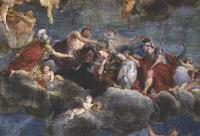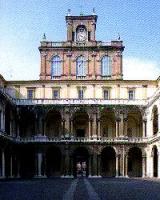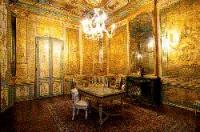 The first step in this transformation
was the building of the Palazzo Ducale, started by Francesco I
in 1634, to a design by B. Avanzini on the remains of Obizzo's
castle. The palace, a fine example of XVII Century secular architecture,
is elegant but massive, with its three towers emerging from two
long wings of three floors each, surmounted by a marble balustrade.
The central tower, featuring a rooftop loggia topped by a small
tower, pillars and its lesenes, has a strong upward thrust balanced
by the drier horizontal lines of the facade featuring pairs of
windows. The building works dragged on for centuries, and the
last statues sculpted by G. Graziosi were only added to
the left-hand balustrade in 1926, replacing the worn wooden originals.
(Anyone wishing to take a closure look at these statues can visit
the Gipsoteca Graziosi in the Palazzo dei Musei, where the plaster
models of Bacchus and Venus are on show). The keynote of the
palace is dignity: large windows with copings that change from
straight to curved to triangular in the succession from the ground
to the second floor, pillars and pilasters, two double bands of
moulding to mark the separation between the floors, curved windows
in the cornice decoration, a marble balustrade surmounted by statues
virtues and characters from mythology, and two imposing muscular
statues (Hercules and Aemilius Lepidus) each side of the main
doorway. Take a look at the Palazzo Ducale from the other end
of via Farini; only the central section is visible, and it blends
with the surrounding buildings imposingly but with a surprisingly
light touch.
The first step in this transformation
was the building of the Palazzo Ducale, started by Francesco I
in 1634, to a design by B. Avanzini on the remains of Obizzo's
castle. The palace, a fine example of XVII Century secular architecture,
is elegant but massive, with its three towers emerging from two
long wings of three floors each, surmounted by a marble balustrade.
The central tower, featuring a rooftop loggia topped by a small
tower, pillars and its lesenes, has a strong upward thrust balanced
by the drier horizontal lines of the facade featuring pairs of
windows. The building works dragged on for centuries, and the
last statues sculpted by G. Graziosi were only added to
the left-hand balustrade in 1926, replacing the worn wooden originals.
(Anyone wishing to take a closure look at these statues can visit
the Gipsoteca Graziosi in the Palazzo dei Musei, where the plaster
models of Bacchus and Venus are on show). The keynote of the
palace is dignity: large windows with copings that change from
straight to curved to triangular in the succession from the ground
to the second floor, pillars and pilasters, two double bands of
moulding to mark the separation between the floors, curved windows
in the cornice decoration, a marble balustrade surmounted by statues
virtues and characters from mythology, and two imposing muscular
statues (Hercules and Aemilius Lepidus) each side of the main
doorway. Take a look at the Palazzo Ducale from the other end
of via Farini; only the central section is visible, and it blends
with the surrounding buildings imposingly but with a surprisingly
light touch.
 The Scuderie Ducali, or Ducal
Stables, built in the XVIII Century on Corso Canalgrande right
beside the palace, are less striking but still worthy of note.
They are now in use as a cavalry barracks.
The Scuderie Ducali, or Ducal
Stables, built in the XVIII Century on Corso Canalgrande right
beside the palace, are less striking but still worthy of note.
They are now in use as a cavalry barracks.
Since it now houses Italy's main Military
Academy, the Palazzo Ducale is only open to the public on
request for guided tours and on 4 November, or the Sunday nearest
to that date. This is the only opportunity for taking a stroll
through the main courtyard, or Cortile d'Onore, beyond
the north facade of the palace, all the way to corso Vittorio
Emanuele II (once the site of Modena's canal port), following
a route much used by the whole city until the beginning of this
century. It is also a chance to admire the sober beauty of the
Cortile d'Onore, with its serliana motif giving it lightness and
an austere elegance, also underlined by the marble balustrades
on the ground and first floors.
 On the left of the Cortile d'Onore,
a side loggia leads to the Scalone d'Onore, or state staircase,
which is the other architectural jewel normally concealed behind
the facade of the Palazzo Ducale, and combines functionality and
solid elegance with an unusual luminosity provided by the fact
that it overlooks two courtyards. The interior of the Palazzo
retains very little of the old ducal residence, the main traces
of which are now found in the picture gallery in the Palazzo dei
Musei. However, XVII paintings remain on the ceilings of the
Salone d'Onore and the adjoining room, and offer interesting examples
of a style which filled spaces while also creating the illusion
of moving beyond them. Naturally, the focus is very much on the
glorification of the Este dukes: in the Salone d'Onore, the warrior
princess Bradamante is being crowned by Jove on Olympus, while
the Este eagle on her shield identifies her as the progenitrix
of the family and its military glories. (These frescoes by M.A.
Franceschini in the Salone d'Onore have unfortunately been obscured
by the smoke of an accidental fire; a better preserved example
is the "San Carlo praying for the plague victims" in
S. Carlo church).
On the left of the Cortile d'Onore,
a side loggia leads to the Scalone d'Onore, or state staircase,
which is the other architectural jewel normally concealed behind
the facade of the Palazzo Ducale, and combines functionality and
solid elegance with an unusual luminosity provided by the fact
that it overlooks two courtyards. The interior of the Palazzo
retains very little of the old ducal residence, the main traces
of which are now found in the picture gallery in the Palazzo dei
Musei. However, XVII paintings remain on the ceilings of the
Salone d'Onore and the adjoining room, and offer interesting examples
of a style which filled spaces while also creating the illusion
of moving beyond them. Naturally, the focus is very much on the
glorification of the Este dukes: in the Salone d'Onore, the warrior
princess Bradamante is being crowned by Jove on Olympus, while
the Este eagle on her shield identifies her as the progenitrix
of the family and its military glories. (These frescoes by M.A.
Franceschini in the Salone d'Onore have unfortunately been obscured
by the smoke of an accidental fire; a better preserved example
is the "San Carlo praying for the plague victims" in
S. Carlo church).
During the last century, the spirit
of the Risorgimento avenged itself on the Este family by placing
the monument to Ciro Menotti, the leader of the
uprising in 1831, who was captured and hanged by Francesco IV,
right in front of the entry to their former palace. The statue
of Liberty in Piazza San Domenico beside the left wing of
the Palazzo Ducale reflects another change of historical fortunes;
taken from its pedestal during the Fascist period, it was re-created
by the local sculptor M. Quartieri and returned to its
place in the early Eighties.
 The first step in this transformation
was the building of the Palazzo Ducale, started by Francesco I
in 1634, to a design by B. Avanzini on the remains of Obizzo's
castle. The palace, a fine example of XVII Century secular architecture,
is elegant but massive, with its three towers emerging from two
long wings of three floors each, surmounted by a marble balustrade.
The central tower, featuring a rooftop loggia topped by a small
tower, pillars and its lesenes, has a strong upward thrust balanced
by the drier horizontal lines of the facade featuring pairs of
windows. The building works dragged on for centuries, and the
last statues sculpted by G. Graziosi were only added to
the left-hand balustrade in 1926, replacing the worn wooden originals.
(Anyone wishing to take a closure look at these statues can visit
the Gipsoteca Graziosi in the Palazzo dei Musei, where the plaster
models of Bacchus and Venus are on show). The keynote of the
palace is dignity: large windows with copings that change from
straight to curved to triangular in the succession from the ground
to the second floor, pillars and pilasters, two double bands of
moulding to mark the separation between the floors, curved windows
in the cornice decoration, a marble balustrade surmounted by statues
virtues and characters from mythology, and two imposing muscular
statues (Hercules and Aemilius Lepidus) each side of the main
doorway. Take a look at the Palazzo Ducale from the other end
of via Farini; only the central section is visible, and it blends
with the surrounding buildings imposingly but with a surprisingly
light touch.
The first step in this transformation
was the building of the Palazzo Ducale, started by Francesco I
in 1634, to a design by B. Avanzini on the remains of Obizzo's
castle. The palace, a fine example of XVII Century secular architecture,
is elegant but massive, with its three towers emerging from two
long wings of three floors each, surmounted by a marble balustrade.
The central tower, featuring a rooftop loggia topped by a small
tower, pillars and its lesenes, has a strong upward thrust balanced
by the drier horizontal lines of the facade featuring pairs of
windows. The building works dragged on for centuries, and the
last statues sculpted by G. Graziosi were only added to
the left-hand balustrade in 1926, replacing the worn wooden originals.
(Anyone wishing to take a closure look at these statues can visit
the Gipsoteca Graziosi in the Palazzo dei Musei, where the plaster
models of Bacchus and Venus are on show). The keynote of the
palace is dignity: large windows with copings that change from
straight to curved to triangular in the succession from the ground
to the second floor, pillars and pilasters, two double bands of
moulding to mark the separation between the floors, curved windows
in the cornice decoration, a marble balustrade surmounted by statues
virtues and characters from mythology, and two imposing muscular
statues (Hercules and Aemilius Lepidus) each side of the main
doorway. Take a look at the Palazzo Ducale from the other end
of via Farini; only the central section is visible, and it blends
with the surrounding buildings imposingly but with a surprisingly
light touch.
 The Scuderie Ducali, or Ducal
Stables, built in the XVIII Century on Corso Canalgrande right
beside the palace, are less striking but still worthy of note.
They are now in use as a cavalry barracks.
The Scuderie Ducali, or Ducal
Stables, built in the XVIII Century on Corso Canalgrande right
beside the palace, are less striking but still worthy of note.
They are now in use as a cavalry barracks.
 On the left of the Cortile d'Onore,
a side loggia leads to the Scalone d'Onore, or state staircase,
which is the other architectural jewel normally concealed behind
the facade of the Palazzo Ducale, and combines functionality and
solid elegance with an unusual luminosity provided by the fact
that it overlooks two courtyards. The interior of the Palazzo
retains very little of the old ducal residence, the main traces
of which are now found in the picture gallery in the Palazzo dei
Musei. However, XVII paintings remain on the ceilings of the
Salone d'Onore and the adjoining room, and offer interesting examples
of a style which filled spaces while also creating the illusion
of moving beyond them. Naturally, the focus is very much on the
glorification of the Este dukes: in the Salone d'Onore, the warrior
princess Bradamante is being crowned by Jove on Olympus, while
the Este eagle on her shield identifies her as the progenitrix
of the family and its military glories. (These frescoes by M.A.
Franceschini in the Salone d'Onore have unfortunately been obscured
by the smoke of an accidental fire; a better preserved example
is the "San Carlo praying for the plague victims" in
S. Carlo church).
On the left of the Cortile d'Onore,
a side loggia leads to the Scalone d'Onore, or state staircase,
which is the other architectural jewel normally concealed behind
the facade of the Palazzo Ducale, and combines functionality and
solid elegance with an unusual luminosity provided by the fact
that it overlooks two courtyards. The interior of the Palazzo
retains very little of the old ducal residence, the main traces
of which are now found in the picture gallery in the Palazzo dei
Musei. However, XVII paintings remain on the ceilings of the
Salone d'Onore and the adjoining room, and offer interesting examples
of a style which filled spaces while also creating the illusion
of moving beyond them. Naturally, the focus is very much on the
glorification of the Este dukes: in the Salone d'Onore, the warrior
princess Bradamante is being crowned by Jove on Olympus, while
the Este eagle on her shield identifies her as the progenitrix
of the family and its military glories. (These frescoes by M.A.
Franceschini in the Salone d'Onore have unfortunately been obscured
by the smoke of an accidental fire; a better preserved example
is the "San Carlo praying for the plague victims" in
S. Carlo church).